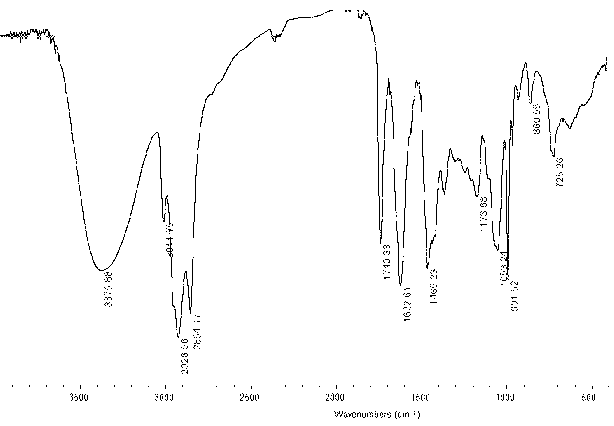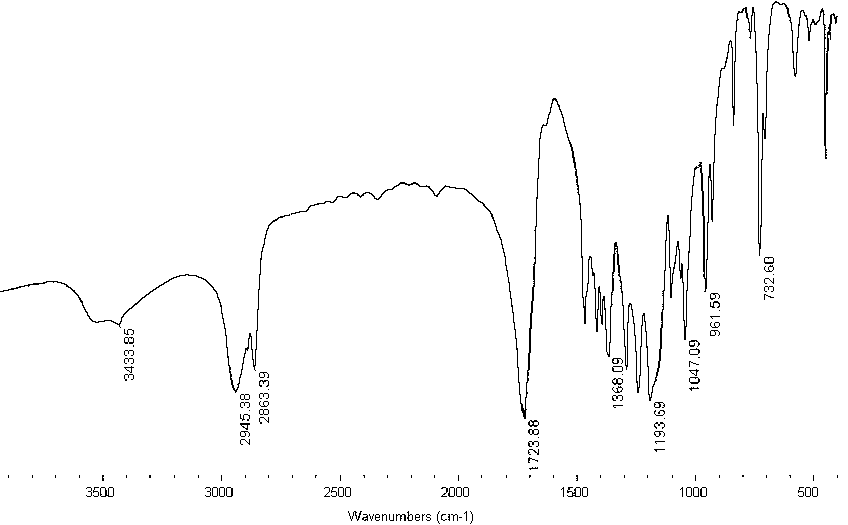Caprolactone-tung oil copolymerized polyol polymer and synthesis method thereof
A technology of copolyol and tung oil polyol, applied in the field of new caprolactone-tung oil copolyol polymer and its synthesis, to achieve the effects of improved weather resistance and aging resistance, good gloss and dry properties
- Summary
- Abstract
- Description
- Claims
- Application Information
AI Technical Summary
Problems solved by technology
Method used
Image
Examples
Embodiment 1
[0029] Equipped with electric stirrer, thermometer, N 2 Add aminolysis tung oil polyol (hydroxyl value 289mgKOH / g) 6.17g, caprolactone (CL) 40.16g and account for 0.1% catalyst stannous octoate of total reactant weight in the four-neck flask of import port, reflux condenser, Start stirring and pass N continuously 2 Air for 30 minutes, heat the oil bath to 150-155°C, keep at this temperature for polymerization for 7 hours, then vacuumize at this temperature to remove unreacted caprolactone, then cool down to 100°C, and obtain caprolactone after cooling - Tung oil copolyol. The hydroxyl value determined by end group titration: OH=33 mgKOH / g, the corresponding number average molecular weight M n =3400. Figure 4 It is the infrared spectrogram of the caprolactone-tung oil copolyol polyol synthesized in the present embodiment.
[0030] attached by Figure 1-5 It can be seen that there is a significant difference between aminolysis tung oil polyol, caprolactone, polycaprolacton...
Embodiment 2
[0032] In the reaction device described in example 1, add aminolysis tung oil polyol (hydroxyl value 324mgKOH / g) 4.16g, caprolactone (CL) 61.18g and account for the catalyst stannous octoate of 0.23% of reactant gross weight, start stirring And continuously pass N 2 Air for 30 minutes, then heat up to 155-170°C with an oil bath, keep at this temperature for polymerization for 7 hours, then vacuumize at this temperature to remove unreacted caprolactone, then cool down to 100°C and discharge, after cooling A caprolactone-tung oil copolyol polymer is obtained. The hydroxyl value determined by end group titration: OH=18.92 mgKOH / g, the corresponding number average molecular weight M n =5930.
Embodiment 3
[0034] Add aminolysis tung oil polyol (hydroxyl value 325mgKOH / g) 3.46g in the reaction device described in example 1, caprolactone (CL) 60.56g and account for the catalyzer stannous octoate of 0.12% of reactant gross weight, start stirring And continuously pass N 2 Gas for 30 minutes, then heat up to 150-160°C with an oil bath, keep the polymerization reaction at this temperature for 7 hours, and then vacuumize at this temperature to remove unreacted caprolactone, then cool down to 100°C and discharge, after cooling A caprolactone-tung oil copolyol polymer is obtained. The hydroxyl value determined by end group titration: OH=17.53mgKOH / g, the corresponding number average molecular weight M n =6400.
PUM
| Property | Measurement | Unit |
|---|---|---|
| hydroxyl value | aaaaa | aaaaa |
| melting point | aaaaa | aaaaa |
| glass transition temperature | aaaaa | aaaaa |
Abstract
Description
Claims
Application Information
 Login to View More
Login to View More - R&D
- Intellectual Property
- Life Sciences
- Materials
- Tech Scout
- Unparalleled Data Quality
- Higher Quality Content
- 60% Fewer Hallucinations
Browse by: Latest US Patents, China's latest patents, Technical Efficacy Thesaurus, Application Domain, Technology Topic, Popular Technical Reports.
© 2025 PatSnap. All rights reserved.Legal|Privacy policy|Modern Slavery Act Transparency Statement|Sitemap|About US| Contact US: help@patsnap.com



